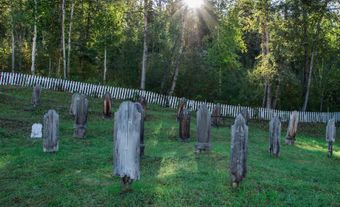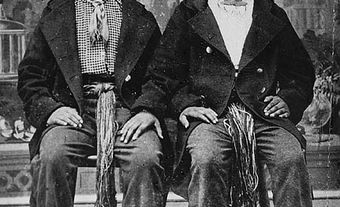Mumming
Mumming, a performance by actors (mummers) in disguise, forms part of a worldwide cultural phenomenon of great complexity. The immediate origin of, and the closest analogies to, the principal Newfoundland mumming practices are found in Ireland and the UK. Many mummers' plays were in the hero-combat tradition of English folk plays and presented variations on a typical fourfold action: the presentation of the characters (eg, St George, the Doctor, Alexander, Sir Guy, the Turkish Knight and others); the combat between one or more antagonists; the cure or resurrection of a slain champion; and the collection of money by performers.
Two practices associated with mumming, the house visit with the performance of a play and the formal outdoor procession or parade, are richly documented from 19th-century sources. After WWI, however, these performances were discontinued, though not forgotten, until their revival by professional actors in the early 1970s, following scholarly research on the tradition. The parade had been a familiar event of the Christmas season as early as 1812, especially in St John's, with elaborately costumed and disguised figures making their way through the streets, flanked by agile fools and "ownshooks" ("female" fools) armed with inflated bladders with which to thrash spectators. A type of performance (a combat or dialogue) was sometimes included at some point in the procession. This public form of mumming, even the wearing of disguise outdoors, was banned under an Act of the Legislative Assembly in 1861 because of the occasional disturbance and violence, but the ban was not effective.
The house visit during the Twelve Days of Christmas by mummers, or "jannies," is particularly common in Newfoundland and is similar to activities by "guisers" in northern England and Scotland, "skaklers" in Shetland, "belsnickles" in the German tradition in both Nova Scotia and Virginia, and "naluyuks" in Labrador. When small groups of people appear at neighbourhood houses and seek admission, there is a reversal of normal modes of behaviour: reversal of sex (through costume disguise); of speech (the mummers' characteristic ingressive speech); of social role (the host is on the defensive); and of behavioural norms (the visitors are boisterous, uninhibited). At the centre of this form of mumming is the attempt by the host(s) to identify the disguised figures; the unveiling of the identified visitors; and the offering of refreshment. This less formal mumming tradition is still widespread in Newfoundland; it has been documented by folklorists and studied by anthropologists.

 Share on Facebook
Share on Facebook Share on X
Share on X Share by Email
Share by Email Share on Google Classroom
Share on Google Classroom


